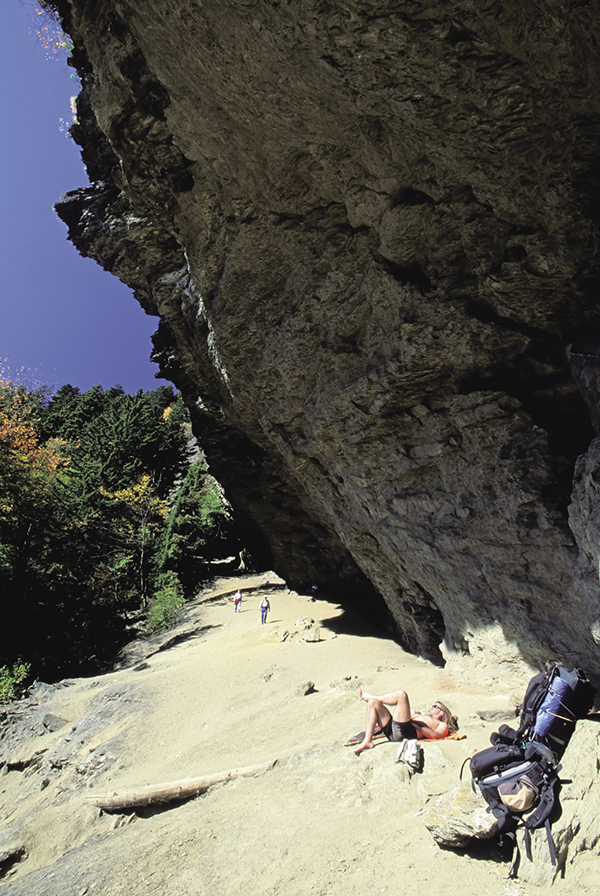
A backpacker takes a breather under Alum Cave Bluffs.
Northeast Section

A backpacker takes a breather under Alum Cave Bluffs.
Hiking to Mount LeConte
The Cascades have Mount Rainier, Yellowstone has Old Faithful, and Great Smoky Mountains National Park has Mount LeConte. At 6,593 feet LeConte is only the third-highest peak in the Smokies, behind Clingmans Dome and Mount Guyot, but in many people’s minds, it’s bigger than Everest. In 1924, when the U.S. government sent a party to study the possibility of creating a national park in the region, a local group of park supporters took them to LeConte. Of all the places in the Smokies from which they could choose, they knew that Mount LeConte would make the biggest impression. The mountain continues to impress.
Three hikes in this guidebook lead to the summit of LeConte: Hike 31, Hike 35, and Hike 37. All three are doable as day hikes, but you also have two options for staying overnight on the summit. Mount LeConte Shelter sits in an open field a few feet below High Top, the highest of LeConte’s peaks. Its amenities are just like any other shelter in the park, except that no fires are allowed. (The sensitive environment on LeConte’s summit is not conducive to the indiscriminate gathering and dragging of firewood that has occurred in the past.) Not too far from the shelter, but still on LeConte’s summit, is LeConte Lodge. Hikers who don’t know anything about LeConte’s history are quite startled when they happen upon the lodge after making what they thought was a hike into the “wilderness.” The lodge opened in the late 1920s and has been in operation ever since, albeit with many improvements along the way. There is no electricity or running water, but modern enhancements include flush toilets and gas heat.
Helicopters fly in supplies for the lodge at the start of the season. (The lodge closes in winter.) During the operating season llamas pack fresh food and clean laundry to the lodge. Passing the llama train on Trillium Gap Trail is a special treat for hikers. The meals rarely change. For dinner, it’s soup and cornbread, stew beef, green beans, mashed potatoes (from a mix), spiced apples, peaches, and a cookie for dessert. Wine is available. For breakfast, it’s pancakes, Canadian bacon, scratch biscuits, grits, and scrambled eggs. The lodge’s famous hot chocolate is served anytime. LeConte Lodge also offers lunch service for day hikers, either as a sack lunch or a sit-down meal, the latter requiring a reservation.
After supper guests hike a short trail to Cliff Top to watch the sunset. Before breakfast a few guests hike out to Myrtle Point to watch the sunrise. Cliff Top is also the site of a number of weddings. Yep, more than one bride and groom have hiked up here with a minister and wedding party and exchanged vows on the rocks of Cliff Top.
Reservations for staying at the lodge are not only required but very hard to get. The number to call is (865) 429-5704. Visit the lodge website (www.lecontelodge.com) for full details.
The three hikes detailed in this guidebook use every trail that leads to LeConte’s summit and cover the most popular and practical hike combinations. A few other options exist if taking advantage of a shuttle service or second vehicle. Study a trail map for possibilities.
Finally, a word of caution. You might think that a winter hike to LeConte would allow you to experience the mountain without encountering hordes of other hikers. You’d be right, but before you embark on such a trek, consider your abilities honestly. That sunny fifty-degree weather you leave in Gatlinburg can turn into a severe snowstorm on LeConte’s summit. Also, the north-facing sections of the rocky trails keep a near-constant glaze of ice throughout winter, making hiking dangerous even when the weather is pleasant. Hiking to LeConte in winter can be a great experience—just make sure you fully prepare for it.